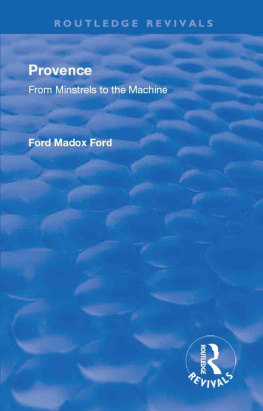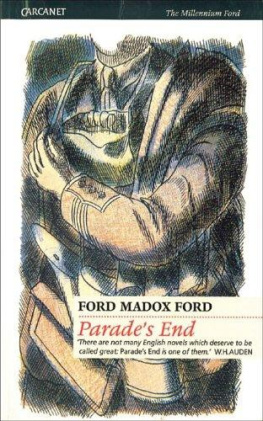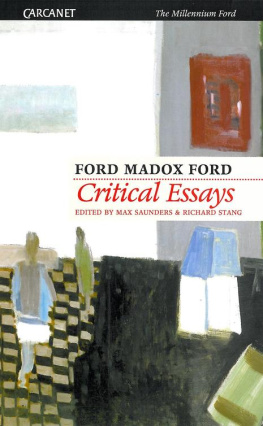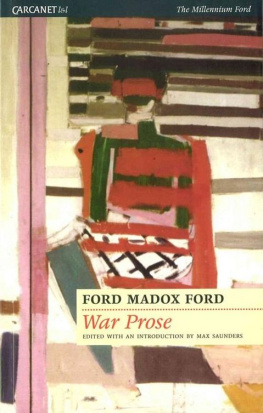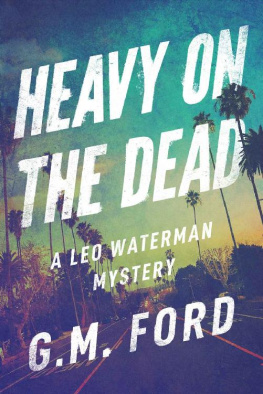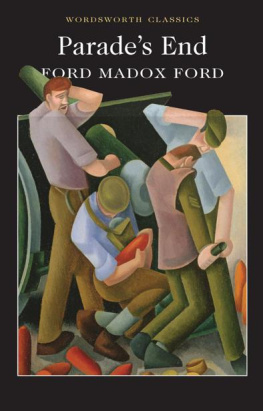Routledge Revivals
PROVENCE
PROVENCE
From Minstrels to the Machine
by
FORD MADOX FORD
LL.D.
First published in 1938 by George Allen & Unwin Ltd.
This edition first published in 2018 by Routledge
2 Park Square, Milton Park, Abingdon, Oxon, OX14 4RN
and by Routledge
711 Third Avenue, New York, NY 10017
Routledge is an imprint of the Taylor & Francis Group, an informa business
1938 Taylor & Francis
All rights reserved. No part of this book may be reprinted or reproduced or utilised in any form or by any electronic, mechanical, or other means, now known or hereafter invented, including photocopying and recording, or in any information storage or retrieval system, without permission in writing from the publishers.
Publishers Note
The publisher has gone to great lengths to ensure the quality of this reprint but points out that some imperfections in the original copies may be apparent.
Disclaimer
The publisher has made every effort to trace copyright holders and welcomes correspondence from those they have been unable to contact. A Library of Congress record exists under ISBN: 39005685
ISBN 13: 978-1-138-55407-8 (hbk)
ISBN 13: 978-1-315-12259-5 (ebk)
Recent books by Ford Madox Ford
GREAT TRADE ROUTE
Extraordinary brilliant .An Indictment, a Philippic. A terrific sociological and philosophical onslaught. He pours out his ideas on every page, original, deep, stimulating ideas. I know of no book to compare with this since Winwood Readers Martyrdom of Man. Brilliant, vital, rushing.A. G. MAC DONELL in The Observer.
Illustrated by Biala. | 12s. 6d. net |
MIGHTIER THAN THE SWORD
MEMORIES AND PORTRAITS
He bursts on to the page almost terrifyingly alive and challenging. He is one of those whom the gods love, and who lives young in consequence. A dazzling series of portraits. When he sits down to his desk he writes as though hes left a sword upstairs.HUMBERT WOLFE in The Observer.
VIVE LE ROY
The elements are familiar, but they have been arranged into a new design, and the fresh juxtapositions invest them with subtle changes of form and colour . A joyful extravaganza to read . His gusto pervades every page . One can almost hear him chuckling as he writes.Time and Tide.
Our finest living novelist.London Mercury.
PROVENCE
PROVENCE
From Minstrels to the Machine
by
FORD MADOX FORD
LL.D.
Illustrations by BIALA
FIRST PUBLISHED IN GREAT BRITAIN IN 1938
COPYRIGHT IN THE U.S.A.
All rights reserved
PRINTED IN GREAT BRITAIN BY UNWIN BROTHERS LTD., WOKING
To
CAROLINE GORDON
who chronicles another south
and to
ALLEN TATE
who came to Provence and there wrote to That Sweet Land the Poem called The Mediterranean and where we went in the boat was a long bay F. M. F. and B.
Contents
Illustrations
LITTLE PLACES WHERE CONTE-FABLES WERE PLAYED
I HAVE told somewhere else the story of the honest merchant who came to Tarascon which is at the heart of Provence on the Greatest of all the Routesdriven there by an elephant. But the book in which I told that story is long out of print, and I do not think it is to treat a reader dishonestly if one repeats in a new book some story or piece of morality that is contained in an old and unobtainable work by the author.
For if the reader wants to read that piece he must, supposing I should here include it, buy this bookor obtain it from his librarysince he cannot get the other without going to more trouble than any sane or normal person would take over a mere book. If on the other hand he should buy this one whilst already possessing the other, one may, as an honest vendor, assume either that he is so mad as not to be considered or that he so likes the writer that he will pardon in him the very slight dishonesty of obtainingfor a new book should be new all throughthe fraction of cent or penny that will be represented by that repetition. I indulge in that speculation to show that considerations of commercial morality are not completely alien to this writer. I may or may not repeat the story of the elephant: if I do I shall now consider the repetition to be justified.
Long ago, then, I was sitting in the Caf de Paris which is the most fashionable caf in the city of the Good King Ren and of St. Martha. That is not to say that it is very fashionable, but that it is the resort of the ex-officers of the famous but disbanded Fourth Lancers as well as of the officers of the brown-skinned, scarlet-fezzed troops that now occupy the casernes of the regiment of Ney. It is also the caf of the notaire, the avou, the avocat, the justice of the peace, of the ex-picture dealer who still possesses Gauguins and Van Goghs that he bought from those artists when they were in Arles at twenty francs a time; and the honestand indeed never to be sufficiently belaudedmerchant who still prints and purveys beautiful bandannas. They have been made in Tarascon for hundreds of years and still shine in and beautify, not only the darkest forests of darkest Africa, but the brightest suns of the most coralline of far Eastern strands. Officers, lawyers, judges, honest merchants, professors, surgeons, landowners twice a day all that Tarascon has of the professional and not too newly-wedded classes meets under those awnings, basks beneath the shade of the planes or shivers beneath the blasts of the immense, life-giving and iced mistral.
And, careful as this writer is of commercial morality, he is not less careful of the company that he keeps, for twice a year, twice a day, he will be found amongst those impeccables taking his vermouth-cassis before lunch and before dinner his mandarin-citron. Twice a year, twice a day for five or six days at a time. For wherever I may be going in the round-and-round of the great beaten track, begin it where you will, stepping on the eternal merry-go-round at the Place de la Concorde, the Promenade des Anglais, Fifth Avenue or Piccadillywherever I may be going on that latest of the Greatest Trade Routes I contrive to fetch up both going and coming for my four or five days in the little city that looks across the Rhone at Beaucaire. Beautiful Beaucaire of the ivorine castle of Nicolette au clair visage, whose feet were so white that they made the very daisies look dim!
I am bound to say that Beaucaire, one of the stations of the great prehistoric Trade Route that ran from Cathay up the Rhone to the Cassiterides and then sighed for more worlds to conquer. Beaucaire that still has her fair that has existed every year on the old merchants taboo ground since before history began . Beaucaire, then, looks far the best when seen across the Rhone, with her white faade and her white tower. And I am equally bound to say that when, the other day, I asked the young lady who presides over the bookshop at Tarascon for a copy of

